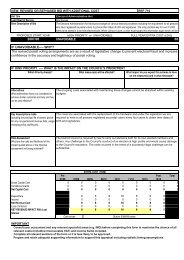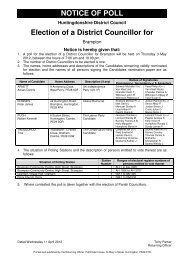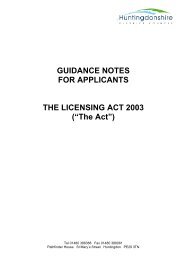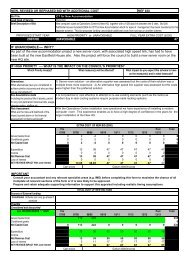Developer Contributions SPD - Huntingdonshire District Council
Developer Contributions SPD - Huntingdonshire District Council
Developer Contributions SPD - Huntingdonshire District Council
- No tags were found...
You also want an ePaper? Increase the reach of your titles
YUMPU automatically turns print PDFs into web optimized ePapers that Google loves.
The Purpose of the <strong>SPD</strong> 2<strong>Huntingdonshire</strong> LDF | <strong>Developer</strong> <strong>Contributions</strong> Supplementary Planning Document2 The Purpose of the <strong>SPD</strong>2.1 <strong>Huntingdonshire</strong> is a focus for housing and economic growth in Cambridgeshire. <strong>Huntingdonshire</strong> <strong>District</strong><strong>Council</strong>, Central Government and Cambridgeshire County <strong>Council</strong> are committed to building sustainablecommunities through a plan led system.2.2 The purpose of the <strong>Developer</strong> <strong>Contributions</strong> <strong>SPD</strong> is to:Explain the <strong>District</strong> <strong>Council</strong>’s policies and procedures for securing developer contributions throughplanning conditions and obligations.Explain the relationship between the required developer contributions and the CommunityInfrastructure Levy in a fair and transparent way.Provide evidence and guidance to developers and landowners about the types of contributions thatwill be sought and the basis for charges.2.3 This will ensure that new development is supported by locally and democratically prioritised communityinfrastructure.Planning Legislation2.4 The statutory framework for planning obligations is set out in Section 106 of the Town and Country PlanningAct 1990 as amended by Section 12 (1) of the Planning and Compensation Act 1991. The Government’sOffice of the Deputy Prime Minister (ODPM) Circular 05/2005 requires planning obligations to meet all ofthe following tests. They have to be:1. Necessary to make a proposal acceptable in planning terms.2. Directly related to the proposed development.3. Fairly and reasonably related in size and type to the proposed development.4. Relevant to planning.5. Reasonable in all other respects.2.5 The Planning Act (2008) also provides the enabling powers for Local Authorities to apply a CommunityInfrastructure Levy (CIL) to development proposals to support infrastructure delivery in an area. LocalAuthorities are entitled to charge a Levy on the basis that it can contribute to well evidenced, costed andjustified community infrastructure.2.6 The CIL Regulations 2010 which provide the detail on the implementation of CIL were published in April,2010. <strong>Developer</strong> Obligations and CIL need to be complementary contribution mechanisms. The Departmentfor Communities and Local Government (DCLG) New Policy Document for Planning Obligations ConsultationDraft March 2010 outlined new statutory restrictions on planning obligations in line with the CIL regulationsthat:Put 3 of the 5 Circular 5/05 tests (numbers 1, 2 and 3 in list above) on a statutory basis fordevelopments which are capable of being charged CIL.Ensure the local use of CIL and planning obligations do not overlap.Limit pooled contributions towards infrastructure which may be funded by CIL.Planning Policy Context2.7 Forthcoming planning reforms are likely to change the planning policy context, particularly through theintroduction of a new National Planning Policy Framework (NPPF) and the Localism Act. However, atthis time, the planning policy context is as set out below.3
















